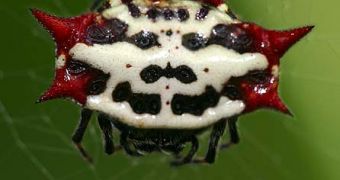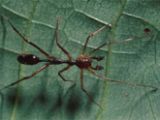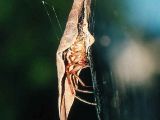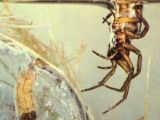Spiders are not insects, as most of us think so, and we try to imitate their silk, which has amazing properties. It is five times more powerful than steel and extremely elastic, stretching by 30% more than nylon (2-4 times before breaking off). Still, it does not vibrate like an elastic web for circus jumps, as it would throw away the spider's food, and it does not get soaked during a rainfall. A fishing web made of spider silk, with fibers having the thickness of a pencil, would stop a passenger plane. There are spider species that can produce even 7 types of silk!
But, many spiders are far away from the image we all have about spiders, and some have really amazing properties.
1. Scuba diving has been invented by a spider! The diving bell spider (Argyroneta aquatica), 9-15 mm long, has the body covered by very fine and dense small hairs and lives in vegetated, fresh, not running water. But, it cannot breathe like fish through gills and must get oxygen from the atmosphere. This means it has to continuously go to the surface, interrupting its lurk and drawing the attention of its prey. That's why the spider has invented "scuba diving" to solve the issue.
Argyroneta uses its silk fibers to make a sack for collecting air, while underwater! The spider binds a few stems of aquatic plants, and weaves its small bell mouth downward, giving it the form and the size of a thimble, made of fine, resistant fibers, well entangled amongst them, so that it can not be crossed by water.
When the sack is ready, the spider goes to the surface. With the belly upside down, it crosses its last pair of feet, catching a few air bubbles between them and the very fine hair from the top of the abdomen. The spider goes to the sack with the air bubbles and, at the top of the bell, it detaches the bubbles. After many such kind of movements, the bell is full of air. As the bell is very light now, it can detach, gushing to the surface, so the spider attaches it with numerous threads to the surrounding plants, like the aerostasts, fixed by strong ropes not to take flight.
When the oxygen in the air of the bell has been depleted, the spider tears the balloon. The air goes to the surface and, patiently, the spider darns the bell and again fills it with fresh air. With the air reserves ‘at hand’, the spider starts lurking, while his breathing organs, located in the abdomen, are inserted inside the bell, its prey being made of insect larvae, water fleas and cyclops.
From the bell there start various alarm fibers. The spiders stay with their feet leaned on these fibers and detect if an animal has touched one fiber, gushing rapidly, catching and paralyzing it with its toxic saliva. The paralyzed prey will be brought into the bell and consumed there, with the spider in an upside down position.
For laying eggs, the female makes a special bell, split in two chambers: in the upper one, with the tip outside the water are laid the eggs, while in the lower chamber lives the mother guarding the eggs. At 5 days old, offspring can make the bells by themselves. During the winter, the spider closes the bell completely, wintering inside its submarine. Some hide into the empty snail shells and cover them with a water-proof silk tap. This spider has quite a painful bite.
2. There are... flying spiders! What they do is actually ... ballooning! They fabric from silk their ... aircrafts!
Thousands of flying money spiders from the Linyphiidae family can flood a terrain on the right days, using their "dragline" silk thread to take on the air. Their ballooning is influenced by wind speed and sunshine. The silk thread is carried by the wind, while the owners clang to the lower extremity. The wind pushes on the thread while the sun heat forms updrafts for the take-off.
3. All spiders have a venomous bite. The effect of this venom varies from totally inoffensive for humans to nasty, painful, and even deadly, in the case of the black widows.
But, the powerful venom of the Brazilian wandering spider (Phoneutria nigriventer) does more than sending you to a hospital: it induces hours-long erection. The toxins induce general pain and higher blood pressure, but also this uncomfortable erection. The active compound is a peptide (short protein) named Tx2-6.
When injected in rats, the animals experienced a significant raise in penis blood pressure and nitric oxide levels within corpora cavernosa, the two cylinders made of spongy tissues running along the penis. The nitric oxide controls the neuronal pathway of an erection. The cGMP enzyme makes the smooth muscles of the penis, corpora cavernosa, relax, so that the blood fills up this tissue, expanding it (till about 10 times more in humans).
But, the PDE-5 breaks down the cGMP, putting an end to the fiesta: the smooth muscles contract and the blood goes out of the penis, which turns back to its limp state. Viagra, Cialis and Levtra act exactly against PDE-5. Tx2-6 works differently: by raising the nitric oxide levels.
4. Promiscuity is widespread amongst spiders, and the question is: if your girl cheats on you, would you break off your penis to impede her? Spiders do it, in the so-called sex war and sperm competition.
In the wasp spiders, the males simply place a chastity belt on their partner while copulating: the tip of their genital breaks off during sexual contact, plugging the sexual orifice of the female. The male wasp spider is much smaller than the female, and after starting the intercourse, few seconds later the female attacks her partner, and if it does not manage a quick escape, it will die. In fact, this is common amongst spiders: the (sometimes much) larger female eats the male. (In order not to fall victims to their sweeties, in many species, the males deliver to their partners a large fly, which will keep them occupied).
In over 80 % of cases, the tip of the penis breaks off, remaining in the sexual orifice of the female like a cork, blocking it. This mechanism ensures that paternity is maintained, preventing or impeding further copulation by the female, acting like a chastity belt. The first male ensures this way that all the egg cells will be fertilized by it. When the female genitalia is plugged, the male copulates only for 8 seconds; otherwise it takes twice longer.
The dwarf spider secrets a viscous stuff in its genital, which it ejects after ejaculation, to make a cork impeding further copulations.
When these two mechanisms of stopping sperm competition are present, the females lay eggs through a separate aperture. Spider species, with only one aperture for copulation and oviposition, do not have such contraceptive strategies.
5. Some spiders have an innate artistic sense, like the St. Andrew's cross spiders (Argiope spiders), which have beautifully adorned webs with zigzag and spiral patterns.
The meaning of the patterned web of Argiope has been a puzzle till recent researches proved that adorned webs caught 60% more insects, but also attracted more spider predators: 70 % more parasitic wasps.
6. Ultraviolet light may harm organisms if it is in excess, but spiders can be turned on by it.
People and mammals, in general, can't detect ultraviolet light, but for jumping spiders it is essential for their mating. These spiders do not weave a web.
Both male and female jumping spiders have markings on their faces and legs that glow in ultraviolet light, males being generally more colorful than females. Tests made with full sun-light spectrum, which compasses UV, triggered in males and females the courtship behaviors (which included bent legs and hunched or flexed abdomens).
Visual spectrum missing UV light left both females and males indifferent to each other. Placing just males in UV light triggered the females' courtship ritual, but 16 of 20 males ignored the females, who could not reflect UV light. Placing just females in UV light produced the opposite: the males started the mating behavior to the glowing females, but 10 of the 12 females remained indifferent.
7. You may have heard about ghost fishes or ghost crabs, but there are also ghost spiders, too. The ghost spider (Anyphaena californica) lives in southern US and gets its name from the translucent look of its body.
8. The spiders of the genus Myrmecium, encountered only in South America, mimic the ants so well, that most people cannot make the difference. This way, these spiders are gaining protection from predators, through their resemblance to aggressive or unpalatable ants.
9. The weirdest looking spiders are the spiny orb-weavers (genus Gasteracantha). Females are measured in centimeters, while the males in millimeters (but this is common amongst spiders). These spider females are really heavy, having the most varied and weirdest pattern of prominent spines and largely varying in shape abdomen. From spike to spike, they can measure 3 cm (1.2 in) in diameter.
A very similar look have the Australian spiders of the genus Austracantha, only that these species are smaller, having less than 1 cm (0.4 in).
10. You know that spiders are solitary creatures. But, some spiders can have a complicated social life, forming colonies made of males and females. The colonies weave common webs, which can have 7 m (23 ft) in diameter, like spiders from Uloboridae family. Such a colony harbors thousands of spiders. In the case of these spiders, each individual has its own hunting net.
But, spiders of the genus Theridion (family Theridiidae) act like a team. The colony members wait for passing prey concealed under the edge of a leaf or stick with threads trailing down beneath them. If an insect gets stuck into the web, the spiders respond en masse, overwhelming it as a team. They can even pull large victims back to their lair.
11. The Australian spiders of the genus Phonognatha use silk in order to weave themselves a shelter from a leaf. The leaf is rolled in spiral and secured with silk fibers, so that it does not unroll. The shelter can also be made of paper, in urban areas, or even of snail shells. The shelter is inserted on the spider's web. During the day, the spider rests inside the leaf, and during the night, when there are more insects, it stalks at the entrance of the shelter.
12.The males of the Australian Peacock spiders (Maratus species) have red, blue and black colored flap-like extensions of the abdomen with white hairs that can be folded down, employed for display during mating: the male expands and raises the flaps so that the abdomen gets a white circular fringe. This is very similar to what peacocks do.

 14 DAY TRIAL //
14 DAY TRIAL // 


